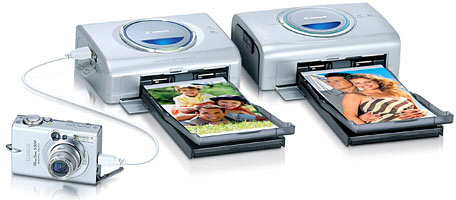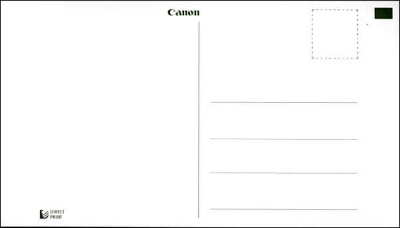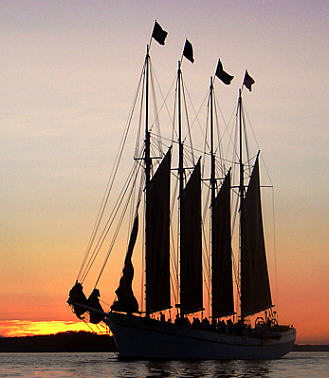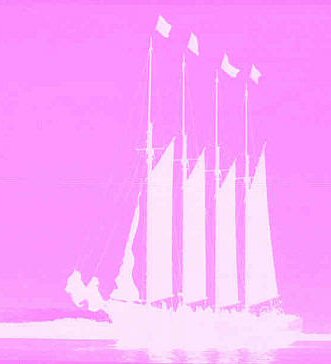
|
Canon CP-220 Compact Photo Printer Review
Canon have recently released two new printers, the CP-220 and CP-330. Both are small format portable dye-sub printers. The major difference is that the CP-330 has built in Li-ion battery power, while the CP-220 requires line power. Both can be operated from a 12v car battery via an adapter (CBA-CP100) which sells for around $90. The printers require 24v to operate, so the car battery adapter has to boost the voltage, which means you can't just kludge an adapter to a 12v supply just using the right cable and connectors. These are small format printers, capable of printing 4x6 prints, credit card sized prints (2.1" x 3.4"), mini-stickers (0.9" x 0.7", 8 to a sheet) and long format 4" x 8" prints. A neat touch is that the special 4" x 6" paper that this printer requires has standard postcard markings on the back (see below), so you can actually send your postcard sized prints as postcards! Each paper size requires it's own cassette. The CP-220 comes with the cassette to hold 4x6 paper, while the CP-330 comes with both the 4x6 and 4x8 cassettes as standard. The credit card size cassette is sold seperately.
Unlike ink jet printers, where you can buy the paper from many suppliers and obtain 3rd party inks, the CP-220 and CP-330 require paper/ink packs sold by Canon. Each pack contains both the paper and the dye-sub ink cassette to print on them. The standard 4x6 pack is the KP-36IP and it will print exactly 36 prints at a cost of around $18, making the cost of each print $0.50. The prints have a sealing layer over them which makes them waterproof and impervious to fingerprints. This is obviously a great advantage if you actually want to mail them as postcards! The printers are quite small (6.7" x 4.7" x 2.2" ), so they'll actually fit into a camera bag, and they're no heavier than a typical SLR (around 30oz). Full printer specifications can be found on the CP-220 specifications page Dye-Sub vs. Ink jetThe CP-220 is a dye-sub (dye sublimation) printer. This means that it it operates by subliming (vaporizing) dye from a sheet onto the printing paper. It does this in 4 passes. On the first pass through the printer the print is in contact with the yellow ink sheet, and areas requiring yellow are transferred from the dye sheet to the paper. Then the print makes a second pass through the printer and this time the dye-sub cassette moves a magenta sheet over the print and transfers dye in the area requiring magenta. On the third pass this is repeated, this time the cyan sheet is used to transfer cyan to the print and the color printing is complete. On a final, fourth, pass a clear protective coating is applied. This is shown schematically in the following figure:
All colors can be made up from yellow, cyan and magenta. Black is all three colors, white is none at all, just as in an ink-jet printer. Below are crops from a sample image and the magenta frame from the dye sub print used to make it. As you can see in the areas of the print that are black, all the magenta has been transferred from the dye sheet. In other areas only some of the magenta is transferred (see the setting sun in the lower right to see an area with partial transfer).
SoftwareThe CP-220 comes with the CP printer solutions disk (CD), which contains both printer drivers and the Canon ZoomBrowser EX software PrintingPrinting can be done from a PC in a manner similar to that used for any printer. A driver is installed for the printer and you select the printer as your output device when printing from a program. A standard USB connection between the printer and PC is used. However the printer can also be connected directly to any Canon camera which supports direct printing, or it can be connected to any PictBridge compliant printer from any manufacturer. I tried printing from PhotoShop as well as directly from a Canon 10D digital SLR using Canon direct print and from an HP-R707 digicam using the PictBridge protocol. All three methods worked equally well with no glitches. Printing from PhotoShop is obviously much more flexible since you can make color and density adjustments before printing. Using all the default setting I found the images just a fraction too cyan, but a very small tweak to the image colors easily fixed that and in general colors seemed accurate and bright. Printing directly from a camera requires a well exposed original since image adjustments aren't possible. Well exposed images printed well. Note that you can print (essentially) full frame from a 10D image which has a 1:1.5 aspect ratio just like 4x6 paper, but if you're printing from a digicam with a 4:3 aspect ratio there has to be some cropping to print 4x6. Each print requires 4 passes of the paper through the printer and the total time for a 4" x 6" print is around 90 seconds. The actual paper is about 4" x 7", with a 1/2" tear off strip at each end. The extra length is required to enable edge to edge (borderless) 4" x 6" printing. The strip is microperforated so it tears off leaving a very clean edge. Bordered prints can also be selected via in camera software when printing directly from a camera, or via the usual software driver options when printing from a computer. Note that the CP-220 comes with a 5 print pack of paper and dye sub ink, so you'll probably want to order at least one 36 print kit with the printer. ConclusionsIf you need a portable printer, the CP-220 is an excellent choice. During the review no glitches occurred and the prints were generally of high quality. The prints are waterproof and fingerprint resistant which is something that may be very useful if you're printing pictures at an event (a party for example), plus they can be sent through the mail as postcards. The only drawback to this portable printer is that it does need AC power to operate. If you want to print somewhere away from available AC power, you'd either need the 12v car adapter (around $80), or you'd need to go for the battery powered CP-330 version which costs about an extra $85. Prints are reasonably priced at around $0.50 each if you buy the 36 print kit ($18) or closer to $0.41 each if you buy the 108 print kit ($45). This is more than online prints would cost, but comparable to the cost of prints from 1hr photo stores.
© Copyright Bob Atkins All Rights Reserved |
|




